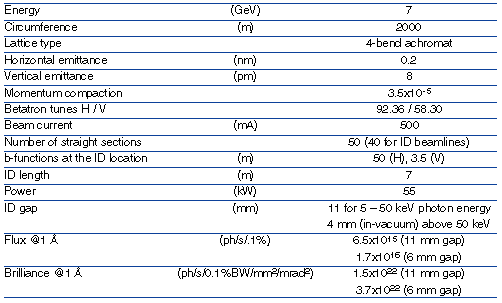- Home
- Users & Science
- Scientific Documentation
- ESRF Highlights
- ESRF Highlights 2001
- The X-ray Source
- Towards the Ultimate Storage-ring-based Hard X-ray Source
Towards the Ultimate Storage-ring-based Hard X-ray Source
A feasibility study of the ultimate storage ring based hard X-ray light source is under way. For the time being, a consistent set of parameters has been established. The main parameters are listed in Table 9.
 |
Table 9: Parameters from the feasibility study of the ultimate storage-ring-based hard X-ray light source. |
The technical feasibility of the main sub-systems is presently being reviewed. The status is the following:
Preliminary considerations of the design of the vacuum system are based on the operational experience at ESRF and other facilities and on the evolution of the machine parameters relevant for the vacuum design (machine energy, beam current and dipole characteristics). In the worst case, the storage ring power would be 3 MW as compared to 1 MW for the ESRF and the required pumping speed would be twice that of the ESRF. Presently, the best solution for the vacuum system appears to be a bakeable, NEG-coated constant-cross-section vacuum chamber, produced by extruding aluminium with massive pumping at the crotch and absorber location.
To avoid a growth of the electron energy spread that would spoil the undulator brilliance at high harmonics, it is of prime importance to avoid the HOM driven coupled bunch instability. Two possiblilities have been reviewed: the use of room temperature cavities with heavy HOM dumpers (such as those developed for PEP-II or DAFNE) or the use of superconducting RF cavities. In this respect a scheme where 6 SOLEIL-type cavities would occupy three straight sections is a possible solution. One of the key features for the RF system will be the number of closed insertion device gaps. They will strongly influence the RF working point (voltage, power, optimum coupling) since the energy loss per turn varies by more than a factor of 2, depending on the number of insertion devices in operation.
As far as transverse instabilities are concerned, one of the critical issues is the machine impedance. Even if the machine is operated with a large number of bunches and low bunch current, the evolution of the instability related parameters with the lowering of the emittance (smaller momentum compaction, smaller synchrotron tune, shorter bunch length, longer damping times) is expected to have a severe impact on thresholds. The use of feedback systems and the minimisation of the impedance are mandatory for achieving the intensity target goal. When compared to the ESRF impedance, the impedance would have to be reduced by at least a factor of 3 to 5.



